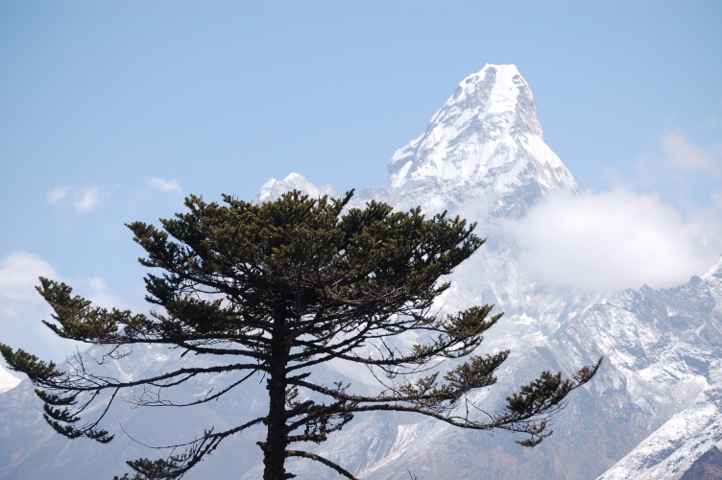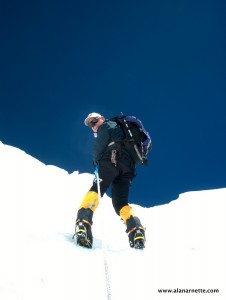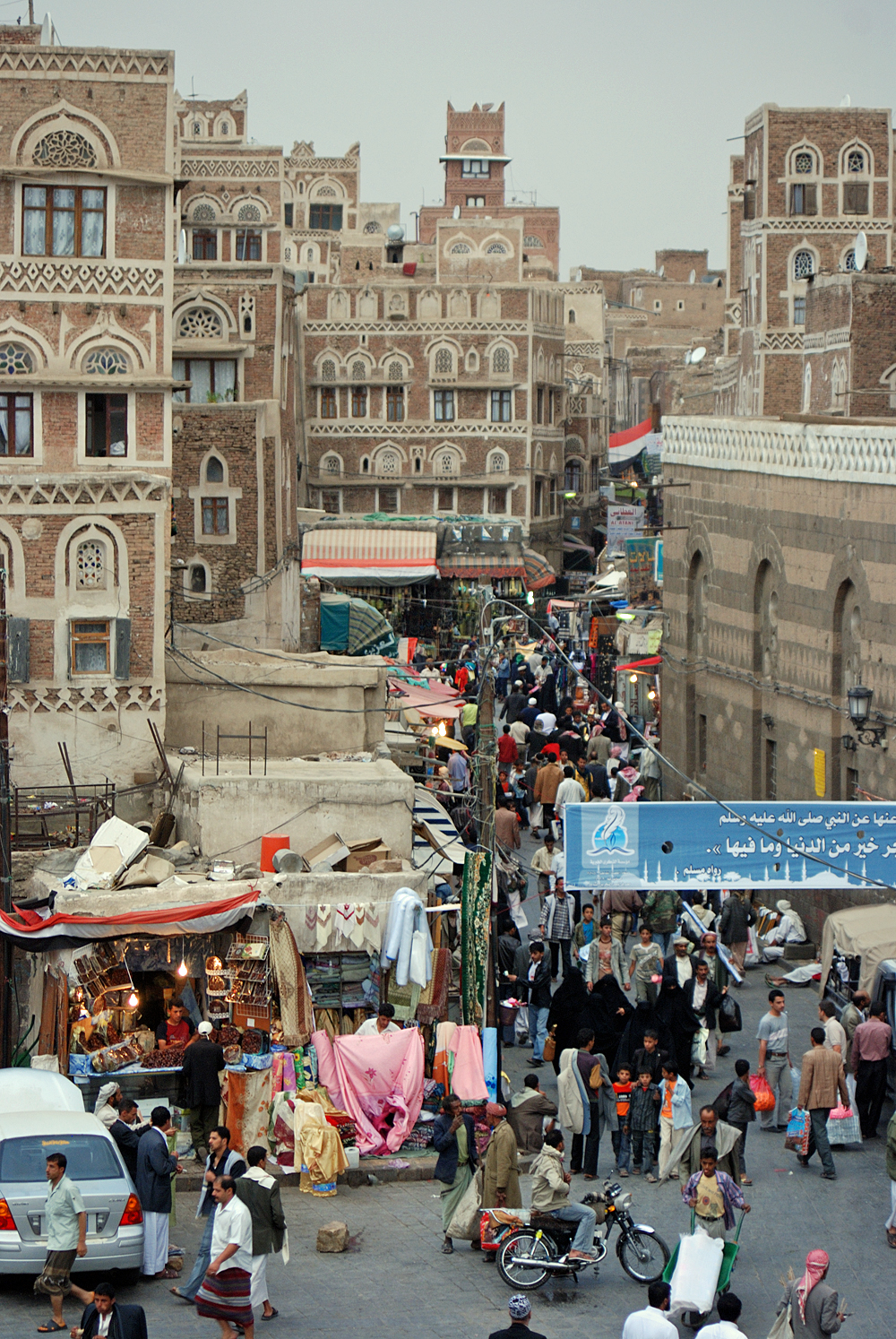During my annual coverage of Everest, one of my most popular posts is about money; well how much money it takes to climb Everest.
What most readers want to know is :
1) how little do I have to spend and
2) where do I get it?
This update for 2014 looks at both questions in detail.
The Big Picture
For 2014, costs have increased pushing the prices higher on both sides, especially for the low cost operators. Those at the high-end have held their prices steady absorbing the increases. The average price of the companies I surveyed looks to be about $48,000 on the south and $37,000 on the north with the primary difference being the permit costs and support staff salaries.
There are real costs involved to climb Everest and it is not the place to save money. However, with guided expeditions charging from $30K to $100K, it is confusing. You can sometimes get a deal, but don’t count on it given the popularity of Everest. Most leading commercial guides sell out months in advance each year.
The Nepal and Tibet governments control much of the costs today with permit fees and requirements on wages, insurance and treatment of Sherpas, cooks and porters so a base price has been effectively established.
There are three ways to climb Everest: put together your own expedition, join a logistics only expedition or join a fully guided team.
Some climbers believe a solo expedition in the Messner 1980 north style is the way to save money; however the notion of a solo climb is somewhat academic today.
Before the explosion of commercially organized guides with dedicated Sherpas, ropes and ladders; a climber could go to the mountain (usually the north) and climb alone without using any of the common support systems. Some people try these days but end up using a ladder someone else put across a crevasse or a cook at base camp thus never really making a true solo climb. The best you can really achieve is without Sherpa support and still the costs are significant.
The majority of climbers use commercial expeditions because they spread the costs across multiple climbers thus reducing expenses and improving safety.
On Your Own
It is tempting to dream of planning your own Everest expedition. After all, anyone can fly to Kathmandu, buy a permit, food for 6 weeks; fly to Lukla or Lhasa, hire yaks and porters to get your gear to BC, establish your own base camp, cook all your own meals, determine your own weather forecast, make multiple climbs to ferry your own gear while establishing your high camps, pay for use of the fixed ropes, buy/rent oxygen, regulator, mask, summit, hire more yaks to get your gear back out or carry it yourself, and a ton of other stuff. It is certainly possible and done occasionally. However even these “independent” expeditions rely on some level of local logistics.
If saving money is the goal, you will be disappointed. You might have been able to do all this for under $15K back in the last century but probably not today. Even the first Swiss and British expeditions were massive undertakings requiring funding on a national level.
Cost Breakdown
To get started on the costs let’s look at the south but the north is similar. There are fees every climber and expedition must pay – directly or indirectly: a climbing permit, liaison officer, visa, park fee, Icefall route management, fixed ropes, waste deposit, travel, insurance. At a minimum these total $13K even sharing the costs with 6 other climbers; for one person going alone, these base expenses soar to over $35K.
Then there is gear, food, tents and more so the shared price increases to $25K minimum – bare bones – no oxygen or Sherpa support; anywhere. Add these in and now for a 7 person team you are at 35K and truly solo approaches $60K.
Realistically, you would join a team to leverage the expenses, especially the permit, but you could try to hire your staff and pay for the normal group expense yourself thus I estimate a “do it yourself” south side expedition for one person with one Sherpa and two cooks will cost between $55K and $85K.
This is my estimated break down and there are additional costs I have not included for example travel, insurance, etc. for the support staff required by the governments.
PERSONAL TRAVEL $2,350 – $6,200
- Airfare $1500 to $5000 depending on class and routing and excess baggage
- Transportation Kathmandu to Lukla $250 roundtrip per person
- Hotel and food in Kathmandu $300 to $700 depending on delays
- Nepal Visa $100
- Immunizations $200
Getting to EBC $2,150
- Yaks to and from Base Camp $150 per yak per day carrying 120lbs
- Porters to and from Base Camp $75 per porter per day carrying 60lbs
- Tea Houses and food on trek to EBC $20 – $100/person /day – 7 days $140 – $700
- Park Fee $100/team
Climbing Fees $11,500 – $23,000
- Nepalese Liaison Officer $3000/team
- South Base Camp Medical support $100/person
- Permit $25,000 for 1 – $70,000 for 7 or$10,000 each
- Garbage and human waste deposit $4,000/team permit (refundable but not always)
- Icefall Doctors to fix route $2500/team
- Contribution to fixed ropes above Icefall $100/climber
- Weather forecast $0 to $3000
- Puja $300
EBC and High Camps $9,900
- Tents $3000 new (sleeping, cooking, toilet, storage at 4 camps for 3 people)
- Cooks $5000 per cook and assistant for 6 weeks
- Food and fuel $1900 per person for 6 weeks
Climbing $8,440
- Oxygen $500/bottle (5 bottles) $2500
- Oxygen Mask (Summit Oxygen) $440
- Oxygen Regulator $500
- Climbing Sherpa $5000 per Personal Sherpa
Misc $12,400 – 19,400
- Medical kit $1000
- Sherpas, cooks tips and bonus $250 – $2000 per individual depending on performance and summit
- Helicopter evacuation from EBC-South $5000 – $20,000 depending on start and end locations (not available on north)
- Rescue Insurance: $400
- Personal Gear (down suit, high altitude boots, sleeping bags, etc): $7000
- Satellite phone (own) $1000 to $3000 depending on usage
- gear allowance for Sherpas $1000
OK, so now that it looks cost prohibitive to climb solo or even very independently for most people, let’s look deeper at climbing with an organized team.
Guide Definition
What is a guide? There are international organizations that certify guides such as the AMGA and the IFMGA. Individuals, after years of practical experience, go through extensive training across all types of terrains and techniques plus rescue and some medical courses before an intensive testing process to receive their certification. This is time consuming and expensive and not common in the US market but almost always required across Europe. Certified guides are technically the best of the best.
Some expeditions are led by a Westerner who does not call himself a guide but rather a leader. The leader coordinates activities, sometimes from base camp and may or may not actually climb with clients. The leader may or may not have actually summited the mountain.
Be aware that anyone can call themselves a guide in Nepal. There are many local companies with slick looking websites that offer attractive packages. Some are excellent but many are high risk. Verify everything.
There are three options for supported climbs: Sherpa supported, Sherpa guided and a western guided commercial expedition. All leverage permit fees and group costs such as deposits, cooks and tents across multiple climbers. Let’s look at them in detail:
Sherpa Supported Expedition
A Sherpa supported expedition is one where a company organizes all the logistics: food, group gear, transportation plus Sherpa support but does not provide traditional western guides or, in some case, even a lead Sherpa guide. The Sherpas may or may not speak English very well and will most likely follow your lead as to pushing forward or turning back.
These cater to experienced climbers or those on a tight budget. You can sign onto one of these climb for under $40,000 on the south side, but you need to read the fine print and strongly consider safety.
At the low end of the price range, a Sherpa will ferry your oxygen gear to the highest camps, prepare all the tents, and carry the group gear but not your personal gear. Don’t underestimate the toll of the simplest tasks at extreme altitude. One service uses a 4:1 ratio of climbers to Sherpa to give you a feel for the level of support. Also, due to the low staffing, some do not help with route fixing creating ill will with other teams.
A Sherpa will climb with you on summit night but you might be on your own with random teammates throughout the rest of the acclimatization climbing process, including preparing meals at the high camps. It is quite common to find yourself climbing only with a Sherpas or even alone. Access to modern weather forecasting technology is unlikely, you may use old style oxygen masks. It is absolutely required to ask many questions and understand every detail before signing onto these style of expeditions. Recent references are a must.
Asian Trekking specializes in this style of climb and is very good but many others are not. I climbed Everest in 2008 with High Altitude Dreams using this model.
Sherpa Guided Expedition
A Sherpa guided expedition will have an experienced Sherpa lead climbers through the route. Usually they depend on a Sirdar (a highly experienced senior Sherpa) to make the big decisions such as when to go for the summit or when to turn-around.
A variation on this approach is to hire a Personal Sherpa. These Sherpas have gained significant experience and training in dealing one to one with western clients. Their English skills are usually very good. A personal Sherpa will be at your side, literally, throughout every step of your climb including all the acclimatization climbs. You will never climb alone.
While they will not carry your gear, they may offload some items from time to time. They will be with you exclusively on your summit night even if you turn around before the summit. Expect to pay an additional $5K to $7K for a Personal Sherpa plus another 5% to 20% in tips and bonuses.
Almost every expedition except for the lowest costs ones, provide a Personal Sherpa on summit day, at an additional fee.
IMG’s Classic Everest Climb program has used this model safely for years. I summited in 2011 with my Personal Sherpa Kami Sherpa from IMG. Expect to pay around $40,000 for this style.
Western Guided Expedition
The western guided expeditions are ‘full service’ trips and are most appropriate for first time Everest climbers or anyone looking for a bit more support. The cost vary widely ranging from $55K to $85K. This includes all the services of a Sherpa guided climb plus sharing one or more western guides. If you want your own personal western guide, expect to pay $100K, plus tips and bonuses.
The major point of this approach is you are climbing in close proximity to a western guide who most likely has several summits of Everest under his/her harness. There is no language barrier and the guide will make all the decisions as to turn around times, weather and manage emergencies.
In addition, with a western guide, you will receive coaching and encouragement but this varies widely amongst the multiple personalities of the guides. A major component of the price difference is that you are paying for this incremental attention and guidance.
On these higher-end expeditions, you should have a high quality of food ranging from better prepared to exotic. One service likes to promote their sushi, another their 5 Star chef. Then there are espresso machines, open bars – in other words the sky’s the limit, all at a cost.
The most expensive guide companies (Adventure Consultants, AAI, etc) almost always come with several western guides and you never climb alone. I climbed Everest in 2002 and 2003 with Adventure Consultants using this model.
Team Size
One area to understand is the size of the team.
The highest price companies, that most often have small teams with western guides, will promote that they offer the benefit of personal attention, camaraderie, teamwork and support. They suggest the large teams are impersonal, and crowded.
My observation is that some small guided teams will try to climb as one group to support the teamwork and leverage the support staff which is good. However, the disadvantage of this is that if you are not feeling 100% you may feel the pressure to go anyway. Sometimes, you can lag a rotation behind, but it is discouraged.
The large teams almost never climb as one huge group. When climbing with a Personal Sherpa, there is a natural grouping that develops with like-minded climbers climbing at their own pace in small groups thus you get the advantage of a small team but leverage the costs more widely. Rarely are you forced to climb if you are not ready. Also you can avoid those “difficult” personalities that are always part of a long expedition.
My observation on large teams is sometimes you can have the feeling of a herd with large camps, unknown faces. Some climbers might feel a bit isolated. However, there is a increased feeling that if something goes wrong, there are a lot of resources on hand.
The bottom line for me has always been what kind of experience do you want. Both large or small teams can be equally successful.
The Grand Dame of all Everest statistics, Ms. Elizabeth Hawley has not published her 2013 summit statics but my very rough, unconfirmed estimates are: Total climbers at base camps: 415 westerners plus 625 Sherpas totaling 1040. 691 combined summits from both sides 67% summit to attempt rate. 9 total deaths.
A Wide Price Range
So, what is the difference between an Everest expedition for $40K and one for $65K? Often it is simply profit, overhead, number of guides and team size. Also how many services are bundled into one single price versus offered as options. The lowest price outfits promote a low price and then offer “options” such as oxygen, Sherpa support or even food above base camp.
Another common practice to keep expedition costs low is to pay support staff the absolute minimum whereas the best guides pay a livable wage for their entire team. It is critical to fully understand what you are getting into. But often it is the availability of resources: extra Sherpas, back up supplies (ropes, tents, oxygen bottles, etc), medical facilities, communications and profit and overhead for the operator. But this is difficult to compare.
An example are Sherpas bonuses. A low price service may not include a bonus whereas another may. For example, one company asks the climber to pay $1500 to his Sherpa if they reach the South Col and another $500 if they leave for the summit. This is not shown as part of the base price. But a different company includes these bonuses in their overall package. In both cases it is customary to tip your Sherpa, and western guide, an additional amount.
Comparison Shopping
With all this as background, I used public websites and my own research to compile the 2014 Everest fees from the major Everest guide companies. Also I looked back at their 2013 summit rates and historical numbers where available. This is not a complete list of all guides and I did not look at small one person operations or those who do not run climbs each year for more than one or two clients.
|
Everest 2014 List Prices and 2013 Summit Rates
|
|||||
|
COMPANY |
Typical Team Size |
SOUTH w Sherpa Guide* |
SOUTH w Western Guide*
|
NORTH |
2013 Summit Success |
| AlpenGlow |
2-4 |
N/A |
$89,000 |
N/A |
2013: 1 of 2 clients, 1 guide, 4 Sherpas |
| Adventure Consultants |
8-12 |
N/A |
$65,000 |
N/A |
2013: 7 of 10 clients, 5 guides, 21 Sherpas257 total summits (clients, Sherpas, guides) since 1990 |
| Alpine Ascents International |
8-16 |
N/A |
$65,000 |
N/A |
2013: 13 of 16 clients, 3 guides, 21 Sherpas.264 total summits (clients, Sherpas, guides) since 1992. 75% success from 2004 |
| Jagged Globe |
8-12 |
N/A |
$58,000 |
N/A |
2013: 10 of 10 clients, 3 guides, 11 Sherpas |
| Mountain Trip |
4-8 |
N/A |
$65,000 |
N/A |
2013: 1 of 4 clients, 0 guide, 4 Sherpas |
| Mountain Madness |
4-8 |
N/A |
$64,000 |
N/A |
no information available |
| Himalayan Experience |
20-30 |
N/A |
$65,000 |
N/A |
2013: 12 of 12 clients summited, 2 of 2 guides, 12 Sherpas364 total summits (clients, Sherpas, guides) since 1994, 0 – 96% success |
| RMI |
4-10 |
N/A |
$59,000 |
N/A |
2013: 0 of 3 clients, 2 guides, 3 Sherpas |
| International Mountain Guides |
12-20 |
$40,000 |
$55,000 |
N/A |
2013: 16 of 31 clients, 4 guides, 24 Sherpas (2 pushes) est.381 total summits (clients, Sherpas, guides) since 1991. 66% from 2006 |
| Kobler & Partner |
8 |
N/A |
$52,400 |
N/A |
no information available |
| Peak Freaks |
8-15 |
$39,000 |
$48,500+ |
N/A |
2013: 4 of 8 clients, 2 guides, 8 Sherpas. |
| 7 Summits Club |
20 |
N/A |
N/A |
$55,740 |
2013: 9 of 13 clients, 1 guide, 9 Sherpas |
| Altitude Junkies |
8-12 |
$42,500 |
N/A |
N/A |
2013 (n): 3 of 9 clients, 1 leader, 7 Sherpas |
| Summit Climb |
5-20 |
N/A |
$36,450 |
$28,450 |
2013: 12 of 12 South and 11 of 14 clients north213 total summits both n and s (clients, Sherpas, guides) |
| Adventure Peaks |
10-20 |
N/A |
2013: 4 of 8 | ||
| Asian Trekking |
20 |
$36,350 est |
N/A |
$29,070 est |
2013 (s):14 of 26 clients, 21 Sherpas2013 (n): 5 of 5 clients, 4 Sherpas310 total summits (clients, Sherpas) since 2003. |
| Tim Mosedale |
4-6 |
$45,000 |
N/A |
2013 4 of 6 clients, 1 Guide, 8 Sherpas | |
N/A = not offered, * full logistics support, gear, food, Personal Sherpa, oxygen, mask and regulator
You can see my thoughts on Everest guides on my main site at Selecting a Guide.
Formulärets överkant
How much would you pay to climb Everest?
- $65K plus
- $50K – $65K
- $35K – $50K
- $25K – $35K
- 15K – $25K
- I would never pay to climb any mountain
Safety
In my mind one of the largest decisions to make in selecting a guide service is your personal safety. The vast majority of Everest rescues and emergencies are never reported to the public – and there are many; almost daily throughout the season. Climbers get altitude sickness, GI issues and debilitating fatigue; your life becomes dependent on those around you.
If you are climbing with a small or a thinly staffed team, there is the possibility of not having adequate resources nearby to help you. It is a serious and sometime fatal mistake to believe that Everest is so crowded that someone will always be around to give aid if needed. Remember that each person is struggling to survive on their own, including the Sherpas, and may not have the strength to help regardless of their desire.
The bottom line is that teams who charge more or field a large team will generally have more resources available to support their clients.
As you can see selecting a guide service can be as daunting as climbing Everest itself! But in the end if you get references from other climbers of similar age and experience, the decision will be clear for you. Never be afraid to ask questions. The best operators welcome your questions. Trust me, they have heard it all. Finally, no legitimate operator wants to bring someone on who is a liability so they are interviewing you as much as you are them.
Funding
Getting the money is almost always harder than climbing Everest. Climbers become very creative when finding money. Some take out loans, refinance their home mortgage, others have the infamous “rich uncle”. Then there are those who set up a website to sell t-shirts or ask for “donations” from strangers. Believe it or not, this actually works to raise some money but rarely enough to cover all the expenses.
But the most common way to fund an Everest climb is to make it a priority in your budget by setting money aside each month for as long as it takes. This is how I funded 26 of my big climbs since starting at age 38.
The question of obtaining a sponsor often comes up. It is extremely difficult to get on a sponsored team for example by one of the large outdoor gear companies. There are ways to obtain a sponsor but it takes years of work, a solid plan, proven experience and often comes down to who you know and a lot of luck.
Climbing for a charity or a cause is popular but be careful not to use your cause as a way to fund a climb. This is a poor practice in my opinion.
You can read more about my own experiences with The 7 Summits Climb for Alzheimer’s: Memories are Everything and thoughts for sponsorship at this link.
Climb On!
Alan
Memories are Everything
112. Alan Arnette is a mountaineer, speaker and Alzheimer´s advocate. His insight into Mount Everest is unique. Read more here!




